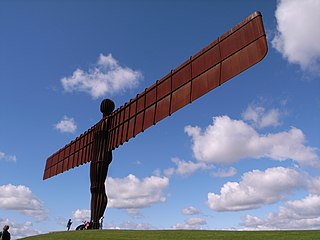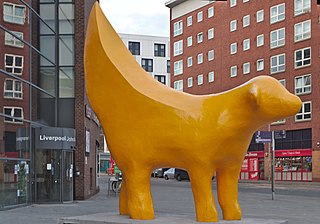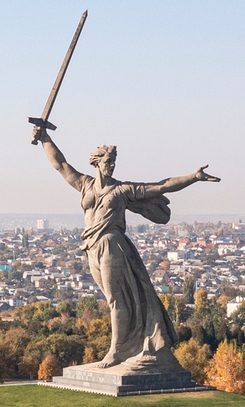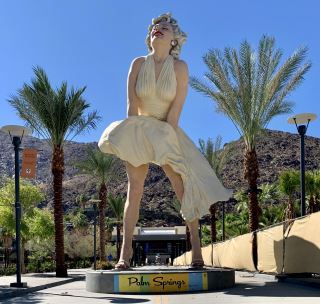
Bronze is an alloy consisting primarily of copper, commonly with about 12–12.5% tin and often with the addition of other metals and sometimes non-metals, such as phosphorus, or metalloids, such as arsenic or silicon. These additions produce a range of alloys that may be harder than copper alone, or have other useful properties, such as strength, ductility, or machinability.

Marc Quinn is a British contemporary visual artist whose work includes sculpture, installation, and painting. Quinn explores "what it is to be human in the world today" through subjects including the body, genetics, identity, environment, and the media. His work has used materials that vary widely, from blood, bread and flowers, to marble and stainless steel. Quinn has been the subject of solo exhibitions at Sir John Soane's Museum, the Tate Gallery, National Portrait Gallery, Fondation Beyeler, Fondazione Prada, and South London Gallery. The artist was a notable member of the Young British Artists movement.

Seaham is a seaside town in County Durham, England. Located on the Durham Coast, Seaham is situated 6 miles south of Sunderland and 13 miles (21 km) east of Durham. The town grew from the late 19th century onwards as a result of investments in its harbour and coal mines. The town is twinned with the German town of Gerlingen.

The Angel of the North is a contemporary sculpture by Antony Gormley, located in Gateshead, Tyne and Wear, England. Completed in 1998, it is seen by an estimated 33 million people every year due to its proximity to the A1 and A167 roads and the East Coast Main Line. The design of the Angel, like many of Gormley's works, is based on Gormley's own body. The COR-TEN weathering steel material gives the sculpture its distinctive rusty, oxidised colour. It stands 20 metres (66 ft) tall with a wingspan of 54 metres (177 ft). The vertical ribs on its body and wings act as an external skeleton which direct oncoming wind to the sculpture's foundations, allowing it to withstand wind speeds of over 100 miles per hour (160 km/h).

The Brodie helmet is a steel combat helmet designed and patented in London in 1915 by Latvian inventor John Leopold Brodie. A modified form of it became the Helmet, Steel, Mark I in Britain and the M1917 Helmet in the US. Colloquially, it was called the shrapnel helmet, battle bowler, Tommy helmet, tin hat, and in the United States the doughboy helmet. It was also known as the dishpan hat, tin pan hat, washbasin and Kelly helmet. The German Army called it the Salatschüssel. The term Brodie is often misused. It is correctly applied only to the original 1915 Brodie's Steel Helmet, War Office Pattern.

Anıtkabir is a mausoleum complex located in the Çankaya district of Ankara, Turkey. It serves as the resting place of Mustafa Kemal Atatürk, founder and first President of the Turkish Republic. Designed by architects Emin Onat and Orhan Arda, the construction of Anıtkabir began in 1944 and was completed in 1953. In addition to the mausoleum, the complex consists of various structures and monuments, as well as a wooded area known as the Peace Park.

Iron Mike is the de facto name of various monuments commemorating servicemen of the United States military. The term "Iron Mike" is uniquely American slang used to refer to men who are especially tough, brave, and inspiring; it was originally a nautical term for a gyrocompass, used to keep a ship on an unwavering course. Because the use of the slang term was popular in the first half of the 20th century, many statues from that period acquired the Iron Mike nickname, and over the generations the artists' titles were largely forgotten. Even official military publications and classroom texts tend to prefer the nickname to the original titles.

Superlambanana is a bright yellow sculpture in Liverpool, England. Weighing almost 8 tonnes and standing at 5.2 metres tall, it is intended to be a cross between a banana and a lamb and was designed by New York City-based Japanese artist Taro Chiezo. It currently stands in Tithebarn Street, outside the Avril Robarts Library of Liverpool John Moores University, having previously been located on Wapping near the Albert Dock.

The National Museum of the History of Ukraine in the Second World War is a memorial complex commemorating the German-Soviet War located in the southern outskirts of the Pechersk district of Kyiv, the capital of Ukraine, on the picturesque hills on the right-bank of the Dnipro River.

The Motherland Calls is a colossal neoclassicist and socialist realist war memorial sculpture on Mamayev Kurgan in Volgograd, Russia. Designed primarily by sculptor Yevgeny Vuchetich with assistance from architect Yakov Belopolsky, the concrete sculpture commemorates the casualties of the Battle of Stalingrad, and is the predominant component of a monument complex, which includes several plazas and other sculptural works. Standing 85 metres (279 ft) tall from the base of its pedestal to its peak, the statue was the tallest in the world upon its completion in 1967, and is the tallest statue in Europe if excluding the pedestal. The statue, along with the rest of the complex, was dedicated on 15 October 1967, and has been listed as a tentative candidate for UNESCO's list of World Heritage Sites since 2014.

Brevet Lt. General Winfield Scott is an equestrian statue in Washington, D.C., that honors career military officer Winfield Scott. The monument stands in the center of Scott Circle, a traffic circle and small park at the convergence of 16th Street, Massachusetts Avenue and Rhode Island Avenue NW. The statue was sculpted by Henry Kirke Brown, whose best-known works include statues of George Washington in New York and Nathanael Greene in Washington, D.C. It was the first of many sculptures honoring Civil War generals that were installed in Washington, D.C.'s traffic circles and squares and was the second statue in the city to honor Scott.

Forever Marilyn is a giant statue of Marilyn Monroe designed by Seward Johnson. The statue is a representation of the image of Monroe taken from Billy Wilder's 1955 film The Seven Year Itch. Created in 2011, the statue has been displayed in a variety of locations in the United States, as well as in Australia.

Don Quixote is a 1976 sculpture by Aurelio Teno located at the northeast corner of the Kennedy Center in Washington, D.C. The sculpture of Don Quixote and his horse Rocinante was a gift from Spain for the United States Bicentennial.

America's Response Monument, subtitled De Oppresso Liber, is a life-and-a-half scale bronze statue in Liberty Park overlooking the National September 11 Memorial & Museum in New York City. Unofficially known as the Horse Soldier Statue, it is the first publicly accessible monument dedicated to the United States Army Special Forces. It was also the first monument near Ground Zero to recognize heroes of the September 11 terrorist attacks.

The African and Caribbean War Memorial in Brixton, London, is the United Kingdom's national memorial to African and Caribbean service personnel who fought in the First and Second World Wars. It originated with a project for a memorial to Caribbean Royal Air Force veterans of World War II who arrived in Britain in 1948 on the MV Empire Windrush; this was an extension of the commemorative plaque and sculpture scheme run by the Nubian Jak Community Trust to highlight the historic contributions of Black and minority ethnic people in Britain. The memorial was originally to have been placed at Tilbury Docks, as part of the commemoration for the centenary of the outbreak of World War I. However, as the project began to evolve into a larger tribute that included both World Wars and commemorated servicemen and women from both Africa and the Caribbean, it was agreed by the memorial recipient – the Port of Tilbury – and the project organisers that a new, more accessible location needed to found. The memorial was ultimately permanently installed and unveiled on 22 June 2017 in Windrush Square, Brixton.

Freddie Gilroy and the Belsen Stragglers is a statue by sculptor Ray Lonsdale which overlooks North Bay of Scarborough, England. Made from weathering steel, the sculpture depicts Freddie Gilroy, a former soldier who participated in the liberation of Bergen-Belsen concentration camp, sitting on a bench in his old age. Gilroy was a friend of the sculptor and Lonsdale made the piece partly as a tribute to him, but also as a wider war and Holocaust memorial. Originally intended to sit on the seafront as a 4-week loan in 2011, a local resident donated money to purchase the sculpture for the town.

The Golden Virgin, also known as The Leaning Virgin, is a gilded sculpture by the French artist Albert Roze originally completed in 1897 and installed on the rooftop of the Basilica of Our Lady of Brebières in Albert, France. Regarded as a symbol of French resilience during World War I, the artwork portrays the Virgin Mary presenting Christ Child heavenward.
Ervin Hervé-Lóránth, often known mononymously as Hervé, is a Hungarian visual artist and creator of several Hungarian and international art exhibitions. He currently serves as a cultural attaché of Hungary. He is also a cultural anthropologist, and an interior architect. The sculptures have been referred to as temporary art, but Hervé-Lóránth refers to his outdoor sculptures as "public surprises".


















